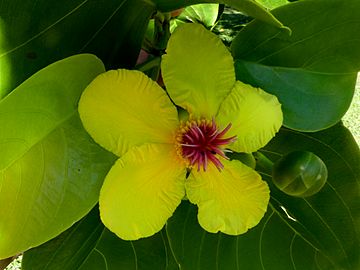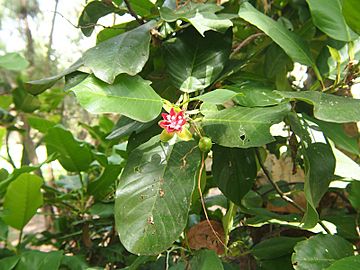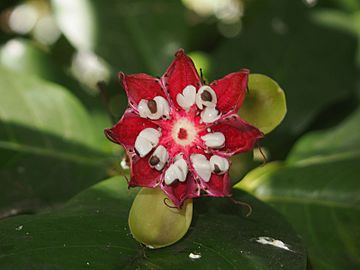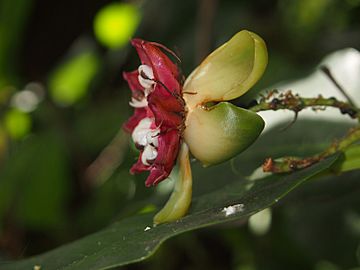Golden guinea tree facts for kids
Quick facts for kids Red beech |
|
|---|---|
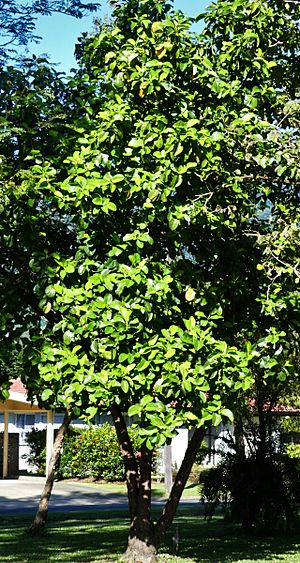 |
|
| Conservation status | |
| Scientific classification | |
| Genus: |
Dillenia
|
| Species: |
alata
|
| Synonyms | |
|
|
The Red Beech (also called Golden Guinea Flower or Golden Guinea Tree) is a beautiful tree found in warm, wet forests. Its scientific name is Dillenia alata. You can find it growing naturally in places like the Maluku Islands (Moluccas), New Guinea, and northern Australia. It belongs to the Dilleniaceae plant family.
Contents
What the Red Beech Looks Like
The Red Beech is a medium-sized tree. It usually grows to be about 10–15 m (33–49 ft) tall. It has a thick, shady top (called a crown). Its bark is special because it's reddish-brown, thin like paper, and peels off in flakes.
Its leaves are shiny and dark green. They are quite large, growing up to 25 cm (9.8 in) long and 12 cm (4.7 in) wide. The leaf stalk, called a petiole, is wide and flat like a wing. This winged stalk wraps around the tree's twig.
Flowers and Fruits
The Red Beech has groups of 2 to 4 flowers that grow on its twigs. These flowers are about 8 cm (3.1 in) across. Each flower has five bright yellow petals. In the middle, there's a big bunch of pinkish-red parts called stamens.
After the flowers, the tree grows red fruits. These fruits are like capsules that open up when they are ripe. They have a green base (called a calyx) that stays on the fruit. When the fruit opens, you can see several small, black seeds. Each seed is covered in a waxy white coating.
How the Red Beech Got its Name
The Red Beech was first named Wormia alata by a Scottish botanist named Robert Brown. Later, in 1817, a Swiss botanist named Augustin Pyramus de Candolle officially described it. He used plants that Joseph Banks collected in Australia in 1770 during James Cook's first big trip.
In 1886, an Italian botanist named Ugolino Martelli moved the tree to the Dillenia group. That's how it got its current scientific name, Dillenia alata.
Meaning of the Names
The name Dillenia honors a German-born botanist named Johann Jacob Dillenius. The second part of the name, alata, comes from a Latin word meaning "winged." This refers to the tree's special winged leaf stalks.
Where the Red Beech Lives
This tree naturally grows in the Maluku Islands, New Guinea, and the Torres Strait islands. You can also find it in northern Australia, in the Northern Territory and Queensland.
It mostly lives in rainforests. However, you might also see it in monsoon forests or even in open forests if the area is wet. It grows best in low areas, especially near the coast, but it can be found up to 600 m (2,000 ft) high.
Red Beech in Nature
The Red Beech is an important part of its ecosystem. A type of moth from Queensland, called Pollanisus commoni, lives on this tree. Also, the fruits of the Red Beech are a favorite food for the colorful Eclectus parrot.
Protecting the Red Beech
Good news! The Red Beech is considered a least concern species. This means it is not currently at risk of disappearing. Organizations like the IUCN and the governments of the Northern Territory Government and Queensland Government have checked on it.
Growing Red Beech Trees
Many people think the Red Beech is a great tree to plant in gardens or parks. David L. Jones, an Australian botanist, wrote in his book Rainforest Plants of Australia that it is "A striking ornamental, common along stream banks and in swampy soils. The leaves, bark, flowers and fruit are all highly decorative features." This means its leaves, bark, flowers, and fruits are all very beautiful and make the tree stand out.
Images for kids



